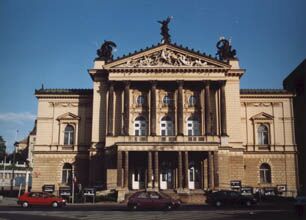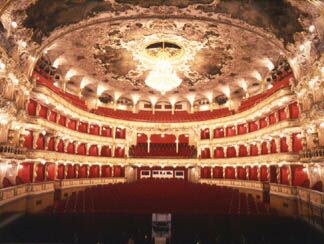|
The Prague State Opera resides in the building which on January 5th, 1888 was opened as a
Prague German stage with the performance of Wagner's opera, The Mastersingers
of Nürnberg. In the 19th century, Prague Germans performed in the Estate's  Theatre in alternation with a Czech company. Desire for their own Theatre led to negotiations in 1883 for the construction of a new Theatre building for the German Theatre Association. Over the next three years, a blueprint was drawn up and handed over to the Vienna atelier of Fellner and Hellmer. Also sharing in the design was the architect of the Vienna Municipal Theatre, Karl Hasenauer, while Prague architect Alfons Wertmüller took part in the construction. Financing came from private collections. With its spacious auditorium and neo-Rococo decoration, this Theatre building is among the most beautiful in Europe. The first director of the new German Theatre was Angelo Neumann, who acquired well known performers and soon brought the new Theatre to a high artistic level of international significance. Major figures which worked here included directors Carl Muck, Franz Schalk and Leo Blech, or singers such as alto V. Nigrini and tenor A. Wallnhöfer. Theatre in alternation with a Czech company. Desire for their own Theatre led to negotiations in 1883 for the construction of a new Theatre building for the German Theatre Association. Over the next three years, a blueprint was drawn up and handed over to the Vienna atelier of Fellner and Hellmer. Also sharing in the design was the architect of the Vienna Municipal Theatre, Karl Hasenauer, while Prague architect Alfons Wertmüller took part in the construction. Financing came from private collections. With its spacious auditorium and neo-Rococo decoration, this Theatre building is among the most beautiful in Europe. The first director of the new German Theatre was Angelo Neumann, who acquired well known performers and soon brought the new Theatre to a high artistic level of international significance. Major figures which worked here included directors Carl Muck, Franz Schalk and Leo Blech, or singers such as alto V. Nigrini and tenor A. Wallnhöfer.
 After Neumann's death in 1910, Alexander Zemlinsky became the director of the opera from 1911 - 1927. A great director and composer, Zemlinsky enriched Prague's cultural life with his unrivalled interpretations of Mozart's works and significant stagings of works by E. Køenek, P. Hindemith, E.W. Korngold, F. Schreker, as well as his own works. During his era, first-rate artists appeared here such as M. Müller, M. Huss, F. Schorr, L. Slezak, R. Tauber, L. Lehmann and others. Under his successor, Georg Szell, works by modern composers were also performed. The Theatre featured a remarkably wide repertoire, even including works from Prague German composers (F. Finke, T. Veidl, H. Krása). The company also had excellent singers at its disposal (R. Pauly, R. Stevens, K. Baum, H. Hotter etc.). The final performance in the Theatre took place on 25.9.1938, when the Theatre Association terminated all contracts and sold the Theatre building to the Czechoslovak state. During the occupation, the Theatre did not have any regular performances under the name of The Prague German Opera. There were only occasional guest performances by a few German companies. Among the exceptional artistic figures who performed here were directors Gustav Mahler, Richard Strauss, Felix Mottl, Arthur Nikisch and Felix Weingartner, as well as soloists Anna Bahr-Mildenburg, Berta Lauterer-Foerster, Maria Jeritza, Nellie Melba, Karl Burian, Enrico Caruso, Benjamino Gigli, Jan Kiepura, Richard Kubla, and Tino Pattiera. After liberation, the building was handed over to the May 5th Theatre, which later became part of the National Theatre. Since its inception in 1992, the Prague State Opera has celebrated the tradition of the New German Theatre, not only through the space in which it plays, but above all through the dramaturgy and establishment of its own documentation center, which would like to archive the activities of the Neues Deutsches Theater (New German Theatre), since the archive of this theatre has unfortunately been irretrievably lost. After Neumann's death in 1910, Alexander Zemlinsky became the director of the opera from 1911 - 1927. A great director and composer, Zemlinsky enriched Prague's cultural life with his unrivalled interpretations of Mozart's works and significant stagings of works by E. Køenek, P. Hindemith, E.W. Korngold, F. Schreker, as well as his own works. During his era, first-rate artists appeared here such as M. Müller, M. Huss, F. Schorr, L. Slezak, R. Tauber, L. Lehmann and others. Under his successor, Georg Szell, works by modern composers were also performed. The Theatre featured a remarkably wide repertoire, even including works from Prague German composers (F. Finke, T. Veidl, H. Krása). The company also had excellent singers at its disposal (R. Pauly, R. Stevens, K. Baum, H. Hotter etc.). The final performance in the Theatre took place on 25.9.1938, when the Theatre Association terminated all contracts and sold the Theatre building to the Czechoslovak state. During the occupation, the Theatre did not have any regular performances under the name of The Prague German Opera. There were only occasional guest performances by a few German companies. Among the exceptional artistic figures who performed here were directors Gustav Mahler, Richard Strauss, Felix Mottl, Arthur Nikisch and Felix Weingartner, as well as soloists Anna Bahr-Mildenburg, Berta Lauterer-Foerster, Maria Jeritza, Nellie Melba, Karl Burian, Enrico Caruso, Benjamino Gigli, Jan Kiepura, Richard Kubla, and Tino Pattiera. After liberation, the building was handed over to the May 5th Theatre, which later became part of the National Theatre. Since its inception in 1992, the Prague State Opera has celebrated the tradition of the New German Theatre, not only through the space in which it plays, but above all through the dramaturgy and establishment of its own documentation center, which would like to archive the activities of the Neues Deutsches Theater (New German Theatre), since the archive of this theatre has unfortunately been irretrievably lost.
|
 Theatre in alternation with a Czech company. Desire for their own Theatre led to negotiations in 1883 for the construction of a new Theatre building for the German Theatre Association. Over the next three years, a blueprint was drawn up and handed over to the Vienna atelier of Fellner and Hellmer. Also sharing in the design was the architect of the Vienna Municipal Theatre, Karl Hasenauer, while Prague architect Alfons Wertmüller took part in the construction. Financing came from private collections. With its spacious auditorium and neo-Rococo decoration, this Theatre building is among the most beautiful in Europe. The first director of the new German Theatre was Angelo Neumann, who acquired well known performers and soon brought the new Theatre to a high artistic level of international significance. Major figures which worked here included directors Carl Muck, Franz Schalk and Leo Blech, or singers such as alto V. Nigrini and tenor A. Wallnhöfer.
Theatre in alternation with a Czech company. Desire for their own Theatre led to negotiations in 1883 for the construction of a new Theatre building for the German Theatre Association. Over the next three years, a blueprint was drawn up and handed over to the Vienna atelier of Fellner and Hellmer. Also sharing in the design was the architect of the Vienna Municipal Theatre, Karl Hasenauer, while Prague architect Alfons Wertmüller took part in the construction. Financing came from private collections. With its spacious auditorium and neo-Rococo decoration, this Theatre building is among the most beautiful in Europe. The first director of the new German Theatre was Angelo Neumann, who acquired well known performers and soon brought the new Theatre to a high artistic level of international significance. Major figures which worked here included directors Carl Muck, Franz Schalk and Leo Blech, or singers such as alto V. Nigrini and tenor A. Wallnhöfer.  After Neumann's death in 1910, Alexander Zemlinsky became the director of the opera from 1911 - 1927. A great director and composer, Zemlinsky enriched Prague's cultural life with his unrivalled interpretations of Mozart's works and significant stagings of works by E. Køenek, P. Hindemith, E.W. Korngold, F. Schreker, as well as his own works. During his era, first-rate artists appeared
After Neumann's death in 1910, Alexander Zemlinsky became the director of the opera from 1911 - 1927. A great director and composer, Zemlinsky enriched Prague's cultural life with his unrivalled interpretations of Mozart's works and significant stagings of works by E. Køenek, P. Hindemith, E.W. Korngold, F. Schreker, as well as his own works. During his era, first-rate artists appeared